
|

|
Forum Index : Windmills : visual effect of capacitors
| Author | Message | ||||
| Ali1 Newbie Joined: 22/12/2008 Location: RomaniaPosts: 3 |
hello all after all your tests, please tell me if schematic of a doubler from page 15 is good and if someone tested with value of the capacitor around 2000uf. I have a chinese windmill at 12v/300w and i want to improve the cutin because at this moment it's need a hurricane to see some amps in the battery. And for those who have an MPPT for PV panels please tell me if it's any deal with that combination in a winter cloudy day, because at this moment when it's cloud i'm not seeing any amps from my 100w PV even if my battery is at 12.6v Thank you all for your interesting work. Alin |
||||
| GWatPE Senior Member Joined: 01/09/2006 Location: AustraliaPosts: 2127 |
Hi Alin, The schematic is good. A better pic is in the CAP article, accessed through the article section here cap article the power passed by the cap voltage doubler will only need to be around 50W with a 300W chinese windmill. 2000uF caps would probably overload the windmill blades, if used in a voltage doubler. The mill will probably stall. I have not tested one of these windmills, but I would think 220uF-470uF DC caps back to back of 200VDC rating would be a better place to start. With the PV, a winter cloudy day. The solar insolation levels may drop to only a few % of a summer cloudless day. If the current increases when the sun emerges, then equipment is probably working. Gordon. become more energy aware |
||||
| JimBo911 Senior Member Joined: 26/03/2009 Location: United StatesPosts: 262 |
Gordon You would think that I know what you mean when you say back to back but I don't? series/parallel wiring? Getting ready to up grade my caps/voltage electronics. Been watching my mill closely looks like I can increase loading at lower RPM's and improve out put. Jim |
||||
| GWatPE Senior Member Joined: 01/09/2006 Location: AustraliaPosts: 2127 |
Hi Jim, read the cap article blue linked in my post above. http://www.thebackshed.com/windmill/articles/GordonsCapMod.a sp This will hopefully clear it up. Gordon. become more energy aware |
||||
| GWatPE Senior Member Joined: 01/09/2006 Location: AustraliaPosts: 2127 |
Some good news for readers. Sparweb has found a neat program simulator that can show us non engineers visually the goings on with the cap voltage multiplier. Here is a link to the program. link. Here is the code needed to be imported that shows a typical cap doubler with normal rectifiers. $ 1 5.0E-6 9.384708165144016 39 15.0 45 v 272 256 272 352 0 1 30.0 30.0 0.0 0.0 0.5 c 640 160 720 160 2 9.92E-4 -17.67901631491416 c 640 224 720 224 2 9.92E-4 -0.351918984121968 c 640 272 720 272 2 9.92E-4 0.3734551172509484 c 640 320 720 320 2 9.92E-4 39.17435240512117 w 640 272 640 320 0 w 640 160 640 224 0 w 272 256 272 160 0 w 272 160 640 160 0 d 976 592 976 528 1 0.6 d 976 480 976 432 1 0.6 d 976 432 976 368 1 0.6 d 880 592 880 528 1 0.6 d 880 480 880 432 1 0.6 d 880 432 880 368 1 0.6 d 784 592 784 528 1 0.6 d 784 480 784 432 1 0.6 d 784 432 784 368 1 0.6 w 784 592 880 592 0 w 880 592 976 592 0 w 784 368 880 368 0 w 880 368 976 368 0 w 720 320 816 320 0 w 816 320 816 528 0 w 816 528 880 528 0 w 720 272 832 272 0 w 832 272 832 432 0 w 832 432 880 432 0 w 720 224 896 224 0 w 896 224 912 240 0 w 912 240 912 528 0 w 912 528 976 528 0 w 720 160 912 160 0 w 912 160 944 192 0 w 944 192 944 432 0 w 944 432 976 432 0 g 976 592 976 624 0 r 976 368 1072 368 0 1.0 z 1072 592 1072 368 1 0.805904783 44.0 w 976 592 1072 592 0 w 272 352 272 592 0 v 352 384 352 480 0 1 30.0 30.0 0.0 2.0943951023931953 0.5 v 496 464 496 592 0 1 30.0 30.0 0.0 4.1887902047863905 0.5 w 352 480 352 592 0 w 352 384 352 320 0 w 352 320 640 320 0 w 496 592 352 592 0 w 352 592 272 592 0 d 784 528 784 480 1 0.805904783 d 880 528 880 480 1 0.805904783 d 976 528 976 480 1 0.805904783 w 976 480 880 480 0 w 880 480 784 480 0 c 720 528 640 528 2 0.0010 0.3609152093302752 w 784 528 720 528 0 c 704 432 640 432 2 0.0010 23.06587609907122 w 784 432 704 432 0 w 640 528 640 432 0 w 640 432 496 432 0 w 496 432 496 464 0 d 1168 592 1168 480 1 0.805904783 d 1168 480 1168 368 1 0.805904783 d 1232 592 1232 480 1 0.805904783 d 1232 480 1232 368 1 0.805904783 d 1280 592 1280 480 1 0.805904783 d 1280 480 1280 368 1 0.805904783 w 1280 368 1232 368 0 w 1232 368 1168 368 0 w 1168 368 1168 304 0 w 1168 304 976 304 0 w 976 304 976 368 0 w 1280 592 1232 592 0 w 1232 592 1168 592 0 w 1168 592 1072 592 0 w 640 528 640 656 0 w 640 656 1312 656 0 w 1312 656 1312 480 0 w 1312 480 1280 480 0 w 352 320 352 112 0 w 352 112 1120 112 0 w 1120 112 1120 480 0 w 1120 480 1168 480 0 w 272 160 272 64 0 w 272 64 1200 64 0 w 1200 64 1200 480 0 w 1200 480 1232 480 0 o 0 64 0 35 40.0 102.4 0 -1 o 38 64 0 35 80.0 51.2 1 -1 This App is an interactive unit, and frequency and voltages and capacitor sizing can be altered, etc. Multiple components can be graphed to show related interactions. Well done Stephen, finding this. I think we are free to download and use it. Here is a pic of typical display. App is good on a large, high res monitor. 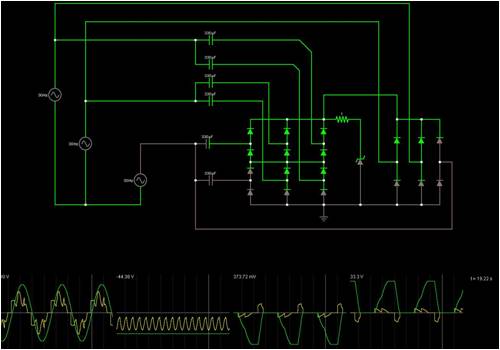
I will run some numbers through and see how it compares with my system. Gordon. become more energy aware |
||||
| KarlJ Guru Joined: 19/05/2008 Location: AustraliaPosts: 1178 |
I'm a bit stumped as to the cap values at 992uf on two phases and 1mf on the other phase, similarly not sure about the resistor or (I think) the zener BUT....does what I thought it would do, caps store below cutin voltage watts upto collapse then release allowing what would have been lost to useful power. all good.... now if only I could change the values to 340UF it would tell me......... Luck favours the well prepared |
||||
| GWatPE Senior Member Joined: 01/09/2006 Location: AustraliaPosts: 2127 |
Hi Karl, this is only a simulator. All the components are variable! Use the mouse to get the edit menu on a component. There is no battery simulator. A resistor limits the current, and the zener simulates a constant voltage sink, like a battery. Am still looking at confirming my measurements. Gordon. become more energy aware |
||||
| GWatPE Senior Member Joined: 01/09/2006 Location: AustraliaPosts: 2127 |
Have run some frequency figs through the simulator, for 340uF caps on my setup with the loading at 52V. I have only done the sim with a doubler and normal rectifiers on my AxFx mill. There are graphs from 13Hz, 15Hz,20Hz,25Hz,30Hz & 40Hz. This corresponds to 130-400RPM on my mill. The 13Hz, is just below cutin, with no current. The 15Hz is just on cutin, with just the peaks pushing through the rectifiers. At 20Hz[15W], current peaks are showing on the caps[lower RHS graph]. At 25Hz[52W], current starts flowing through the main rectifiers, and this reduces the power through the caps. At 30Hz[123W], current through the caps still reducing, and more power through main rectifiers. At 40Hz[850W], most current is through main rectifiers. These are the pics of the sim. 13Hz. 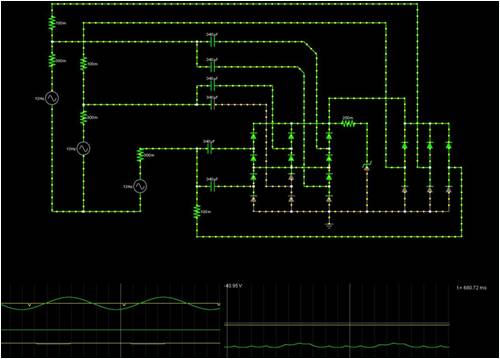
15Hz. 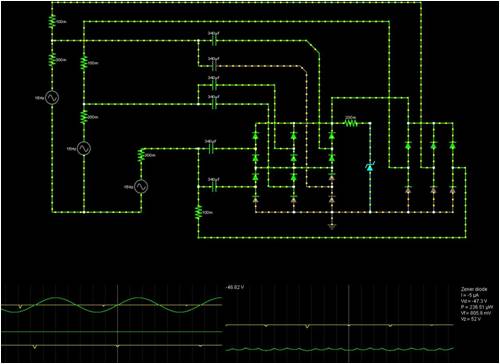
20Hz. 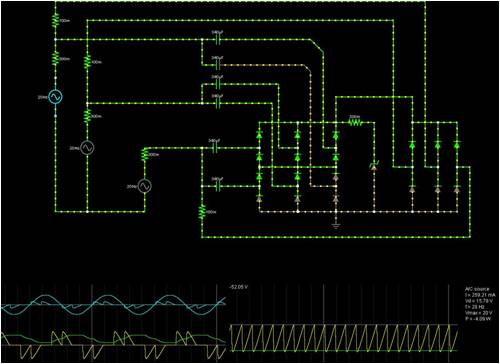
25Hz. 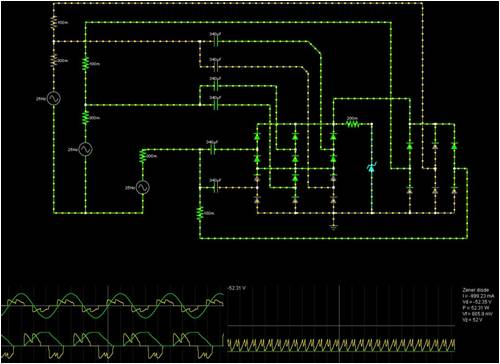
30Hz. 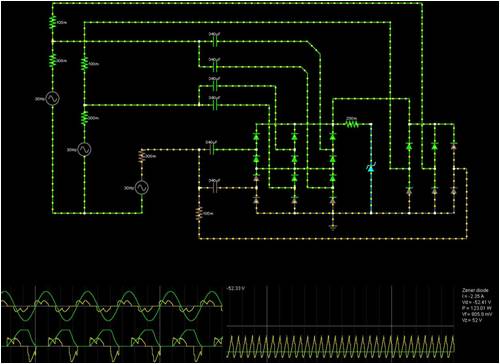
40Hz. 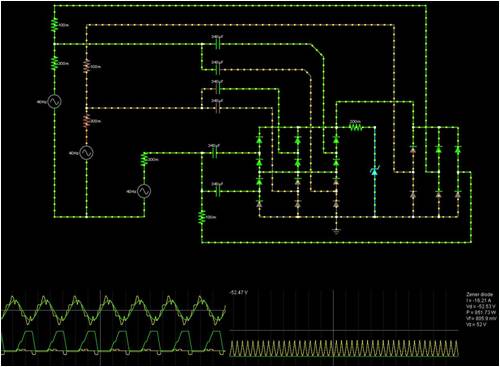
The simulator produces results , but not real close to my measurements. A tool is now available for others to test rough cap sizing for their own windmills. As long as the reader can work out the AC frequency for a particular rpm, and the output voltage at those rpm, and the system voltage, and the power, a range of caps can be tried to see how they go, without spending any money. I may get to look at F&P numbers, but someone with a F&P mill would be more suited. Gordon. become more energy aware |
||||
SparWeb Senior Member Joined: 17/04/2008 Location: CanadaPosts: 196 |
Hi Gordon! I knew this would catch your eye! I made my diagrams a bit more compact, so anyone who is having trouble with yours can try this on a 1024 pixel wide screen: 

The code to generate this is here: Link to text file for this circuit. I've run lots of versions so there are different capacitor values in certain circuits - I keep changing them to see what happens. I put two switches into the circuit so that I can "shut off" the caps to check the difference. Usually the current through the normal recitifer becomes a few milli- or micro-amps. When on, the current goes up as the capacitor value goes up. With extremely high values for capacitors (1000's of uF) I can get several amps. As it is, the circuits model a Star-connected generator with 15vac on each phase. Across the line wires you'd measure 25.9 Vac peak. This is just below cut-in for the 26VAC battery, meaning the capacitors are successfully providing a charging current when normally there would be none. Steven T. Fahey |
||||
SparWeb Senior Member Joined: 17/04/2008 Location: CanadaPosts: 196 |
Gordon, why do you think there is no battery? Left-click, select input/output, and in the list is a "voltage source (2-terminal)" which is the equivalent to a battery. Naturally, it does not have the subtle characteristics of a flooded lead acid battery. This model will "clamp" the voltage perfectly. Likewise, the AC voltage sources have absolutely no inductive reaction to current. This is just a computer model, after all - but a dammed fancy one! And that's its real value: illustration of the concept. I'll go back to Spice when I want real figures. Steven T. Fahey |
||||
| GWatPE Senior Member Joined: 01/09/2006 Location: AustraliaPosts: 2127 |
Hi Sparweb, I get convergence failed errors when switches are closed. Simulator seems to handle simple stuff OK. Is there a reason for not having your 3phase all 120 degrees apart? phase B is at 300 degrees, not 120. My arrangement starts to get problems when I add series caps to the normal rectifiers inputs as well. may be just better to simulate individually, and add manually. The ccts are in parallel, so this should be OK. just a bit more work. Gordon. become more energy aware |
||||
| GWatPE Senior Member Joined: 01/09/2006 Location: AustraliaPosts: 2127 |
I am not thrilled with the Java APP anymore. All seems OK until you need to alter the schematic. Which way a new component is placed, even a wire link seems to affect the simulation. Don't see a solution. A complex drawing should not need to be completely redone to accomodate a wiring change. Others with more patience may have better luck, but I am close to done. At least the cct function is confirmed. Gordon. become more energy aware |
||||
| GWatPE Senior Member Joined: 01/09/2006 Location: AustraliaPosts: 2127 |
This may be a little off my topic, but I have sourced a new logger, that will allow 16 analogue channels to be simultanously recorded. I hope to be able to get more useful data at up to 1000 readings/sec. I hope to gather some "on windmill" data in the next few weeks. Should be able to actually measure the AC, and DC like a DSO, as there is a burst mode of 1MS/sec. I already have written a 12 channel data viewing app, so adding a few more channels should be OK. Hopefully I will get to see how all the components work together. Gordon. become more energy aware |
||||
SparWeb Senior Member Joined: 17/04/2008 Location: CanadaPosts: 196 |
<i>...there is a burst mode of 1MS/sec.</i> Oh boy you will be swimming in numbers! Can each of the measurements have separate + and - references, or will they all have the same ground reference? I'm really improving my understanding by breaking down the problem into single-phase circuits. Easier to visualize, less troublesome in that java circuit thingy, and the math is much easier to handle. Steven T. Fahey |
||||
| GWatPE Senior Member Joined: 01/09/2006 Location: AustraliaPosts: 2127 |
Hi Sparweb, in the single phase arrangement, you will have more ripple. The single phase makes the parallel winding loading and the series output loading more obvious. The logger has a couple of models. 12, or 16 channels, and 10, or 12bit resolution. The 1MS/sec rate is designed for Scope mode, not data logging. To be able to view the simultanous voltages on up to 16 channels will be so informative. There are no differential or isolated inputs. The Alegro current sensors, in conjunction with opto coupled, and cap coupled voltage sensing should cover most bases. I will be testing to see what works. The unit is a PicoLog 1000 series. This is not a PicLog, but my own APP may look similar. The unit is USB powered and has drivers for winXP, and Vista, and Win7. These are UK made devices, and the 12 channel 10bit base model is listed at AU$201. I hope to confirm the simulator voltage and current waveforms. Gordon. become more energy aware |
||||
| GWatPE Senior Member Joined: 01/09/2006 Location: AustraliaPosts: 2127 |
Just an update on the logger I mentioned above. No luck yet with the software. The factory supplied program is OK for snapshots of known number of recordings, or times, but Useless for unattended logging. Software crashes relentlessly as well. I have emailed the manufacturer for driver details, so at least I can have a go writing my own program. Company seems to have automotive diagnostics high up the list. Gordon. become more energy aware |
||||
| GWatPE Senior Member Joined: 01/09/2006 Location: AustraliaPosts: 2127 |
I have been able to get the PicoLog to work now. The PicoScope can monitor all 16 channels simultanously, and they can be grouped to allow easy visual comparisons I have now got some new hall effect current transducers as well. It will now be a task of splicing all the bits into the wiring and getting some data. An interesting feature is that the timebase can be different for each channel, and the unit has a chart feature with memory. This allows going back through a stored trace and even zooming in on a particular section, not only with amplitude, but with timebase as well. I have also got the long term logging sorted, and can log all 16 channels, in a similar format to my Current cost metering, with graphing, and post recording .csv file generation for more complicated spreadsheet stuff. The PicoScope also has mathematical calcs on the inputs, so in theory DC-DC converter efficiency can be looked at in real time, and compared to the power transferred. It will be interesting to see if the unit can work with the various capacitor components to show relative power through each, in real time, in response to say wind gusts. Where is the wind when you want to start some testing? Gordon. become more energy aware |
||||
| GWatPE Senior Member Joined: 01/09/2006 Location: AustraliaPosts: 2127 |
Back on topic again after some diversions. I have come up with a new way to reduce the capacitor count to half for a cap doubler. I faced the problem of not having quite enough caps to complete a doubler for my new windmill, so I went thinking of a solution. I had thought that considering the number of readers who had viewed these pages that a bright spark may have come up with a this and posted before me, but not to be. The key should be in the way I drew my original cct. I will leave this open for the moment and see if anyone else may have a similar solution. I will be confirming my idea in the next few days, with some real world testing. It is late, so I won't spill the beans until I can draw up some pics as well. Gordon. become more energy aware |
||||
Downwind Guru Joined: 09/09/2009 Location: AustraliaPosts: 2333 |
You should be able to cut your bridges back by half as well. I would think by reducing the number of capacitors by 1/2 per phase you would need to double their value to receive the same result. Just a wild guess. Pete. Sometimes it just works |
||||
| GWatPE Senior Member Joined: 01/09/2006 Location: AustraliaPosts: 2127 |
Hi Pete, The bridge count stays the same, and the AC cap count for a doubler would be halved. I am in the process of confirming things, now I have logging and the real time and historical power vs rpm available at the click of a button. Just need a bit more wind. Gordon. become more energy aware |
||||